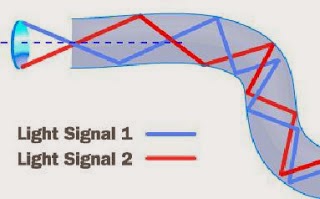How do fiber optic cables work?
Fiber optics (optical
fibers) are long, thin strands of very pure glass about the diameter of a human
hair. They are arranged in bundles called optical cables and used to
transmit light signals over long distances.
If you look closely at
a single optical fiber, you will see that it has the following parts:
- Core - Thin glass center of the fiber where the light travels
- Cladding - Outer optical material surrounding the core that reflects the light back into the core
- Buffer coating - Plastic coating that protects the fiber from damage and moisture
Hundreds or thousands
of these optical fibers are arranged in bundles in optical cables. The bundles
are protected by the cable's outer covering, called a jacket.
- Optical fibers come in two types:
- Single-mode fibers
- Multi-mode fibers
Single-mode fibers have
small cores (about 3.5 x 10-4 inches or 9 microns in diameter) and
transmit infrared laser light (wavelength = 1,300 to 1,550
nanometers). Multi-mode fibers have larger cores (about 2.5 x 10-3 inches
or 62.5 microns in diameter) and transmit infrared light (wavelength = 850 to
1,300 nm) from light-emitting diodes (LEDs).
Some optical fibers
can be made from plastic. These fibers have a large core (0.04 inches or 1
mm diameter) and transmit visible red light (wavelength = 650 nm) from LEDs.
How Does an Optical Fiber Transmit
Light?
Suppose
you want to shine a flashlight beam down a long, straight hallway. Just point
the beam straight down the hallway -- light travels in straight lines, so it is
no problem. What if the hallway has a bend in it? You could place a mirror at
the bend to reflect the light beam around the corner. What if the hallway is
very winding with multiple bends? You might line the walls with mirrors and
angle the beam so that it bounces from side-to-side all along the hallway. This
is exactly what happens in an optical fiber.
The
light in a fiber-optic cable travels through the core (hallway) by constantly
bouncing from the cladding (mirror-lined walls), a principle called total
internal reflection. Because the cladding does not absorb any light from the core,
the light wave can travel great distances.
However,
some of the light signal degrades within
the fiber, mostly due to impurities in the glass. The extent that the signal
degrades depends on the purity of the glass and the wavelength of the
transmitted light (for example, 850 nm = 60 to 75 percent/km; 1,300 nm = 50 to
60 percent/km; 1,550 nm is greater than 50 percent/km). Some premium optical
fibers show much less signal degradation -- less than 10 percent/km at 1,550
nm.
Advantages of Fiber Optics
Why are fiber-optic systems
revolutionizing telecommunications? Compared to conventional metal wire (copper
wire), optical fibers are:
Less expensive -
Several miles of optical cable can be made cheaper than equivalent lengths of
copper wire. This saves your provider (cable TV, Internet) and you money. Thinner -
Optical fibers can be drawn to smaller diameters than copper wire. Higher
carrying capacity - Because optical fibers are thinner than copper wires,
more fibers can be bundled into a given-diameter cable than copper wires. This
allows more phone lines to go over the same cable or more channels to come
through the cable into your cable TV box.Less signal degradation - The
loss of signal in optical fiber is less than in copper wire. Light signals -
Unlike electrical signals in copper wires, light signals from one fiber do not
interfere with those of other fibers in the same cable. This means clearer
phone conversations or TV reception. Low power - Because signals in
optical fibers degrade less, lower-power transmitters can be used instead of
the high-voltage electrical transmitters needed for copper wires. Again, this
saves your provider and you money. Digital signals - Optical fibers
are ideally suited for carrying digital information, which is especially useful
in computer networks. Non-flammable - Because no electricity is
passed through optical fibers, there is no fire hazard.Lightweight - An
optical cable weighs less than a comparable copper wire cable. Fiber-optic
cables take up less space in the ground. Flexible - Because fiber
optics are so flexible and can transmit and receive light, they are used in
many flexible digital cameras for the following purposes:
- Medical imaging - in bronchoscopes, endoscopes, laparoscopes
- Mechanical imaging - inspecting mechanical welds in pipes and engines (in airplanes, rockets, space shuttles, cars)
- Plumbing - to inspect sewer lines
Because of these
advantages, you see fiber optics in many industries, most notably
telecommunications and computer networks. For example, if you telephone Europe
from the United States (or vice versa) and the signal is bounced off a
communications satellite, you often hear an echo on the line. But with
transatlantic fiber-optic cables, you have a direct connection with no echoes.
Visit Us : @ Hyperjet







.jpg)



0 comments:
Post a Comment